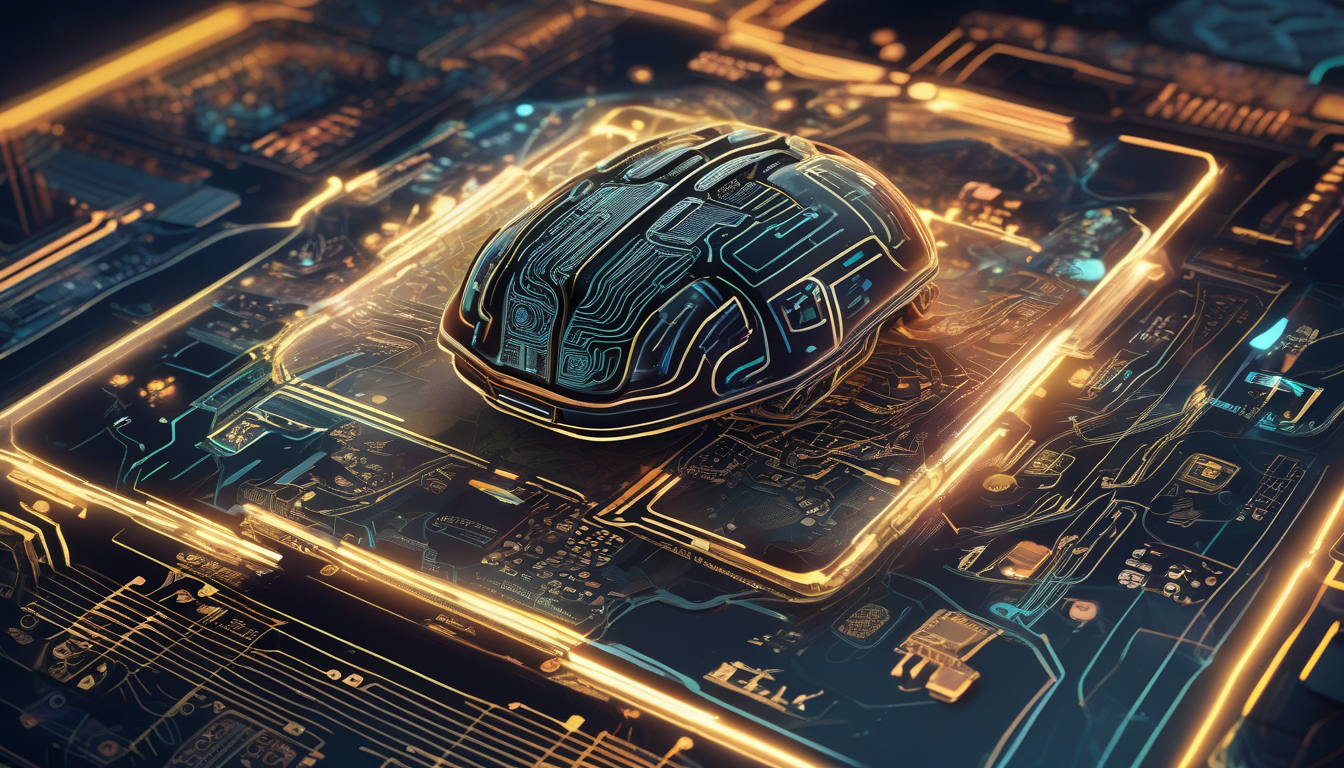Elon Musk’s Plan for the Future of Brain-Computer Interfaces

In a world where technology evolves at lightning speed, Elon Musk stands at the forefront, envisioning a future where our brains communicate directly with computers. This concept, known as brain-computer interfaces (BCIs), is not just a figment of science fiction; it’s a rapidly developing field that could redefine our relationship with technology. Imagine a world where you can control devices with mere thoughts or enhance your cognitive abilities—sounds like a dream, right? Well, Musk believes this dream is within reach.
At the core of Musk’s vision is Neuralink, a company he co-founded that is dedicated to creating advanced BCI technology. By harnessing the power of neuroscience and engineering, Neuralink aims to bridge the gap between humans and machines. The implications of this technology are staggering, potentially allowing individuals with neurological disorders to regain lost functions, while also paving the way for enhanced learning and communication.
However, as we dive deeper into the realm of BCIs, we must also confront the ethical and societal challenges that accompany such advancements. For instance, the idea of implanting devices in our brains raises questions about privacy and consent. What happens if our thoughts can be accessed or manipulated? These are not just hypothetical concerns; they are issues that need to be addressed as we move towards human trials.
Furthermore, the potential applications of BCIs extend beyond medical treatment. They could revolutionize the way we interact with technology in our daily lives, leading to advancements in fields such as education and entertainment. Picture a classroom where students can learn at an accelerated pace by directly interfacing with educational software, or a gaming experience that immerses players in virtual worlds through thought alone.
Yet, with great power comes great responsibility. The development of BCIs presents challenges such as cybersecurity risks and the need for ethical guidelines to ensure fair access and use of this technology. As we stand on the brink of this new era, it’s crucial that we engage in meaningful discussions about the implications of BCIs on our society and what it means to be human in a world intertwined with technology.

The Concept of Brain-Computer Interfaces
Brain-computer interfaces (BCIs) are not just a futuristic concept; they are a groundbreaking leap into a new era of technology that could redefine how we interact with the world around us. Imagine a world where your thoughts can directly control devices—no more cumbersome remotes or touchscreens. Instead, your brain becomes the ultimate controller, allowing for an unprecedented level of interaction with technology.
At their core, BCIs create a direct pathway between the brain and external devices, facilitating a seamless exchange of information. This technology works by detecting brain signals and translating them into commands that machines can understand. It’s like having a conversation with your computer, but instead of speaking, you’re simply thinking. This revolutionary approach could lead to significant enhancements in various fields, including medicine, communication, and even entertainment.
One of the most exciting aspects of BCIs is their potential to assist individuals with disabilities. For example, those with mobility impairments could regain control over their environment, operating wheelchairs or prosthetic limbs through thought alone. This capability not only empowers users but also promotes independence and improves quality of life. The implications are profound, suggesting a future where technology adapts to human needs rather than the other way around.
However, the journey toward widespread BCI adoption is not without challenges. As we delve deeper into this technology, we must consider the ethical ramifications and societal impacts. Questions arise about privacy, consent, and the potential for misuse. For instance, if our thoughts can be translated into digital commands, what safeguards are in place to protect our mental privacy? These are crucial discussions that must accompany the technological advancements.
In summary, brain-computer interfaces represent a thrilling frontier in technology, blending neuroscience with engineering to open new doors for human capability. As we explore this fascinating intersection, we must remain vigilant about the ethical considerations and societal implications that come with such powerful tools. The future of BCIs is bright, but it requires careful navigation to ensure it benefits all of humanity.

Neuralink: Pioneering BCI Technology
Neuralink, co-founded by the visionary Elon Musk, is at the forefront of brain-computer interface (BCI) technology, aiming to create a seamless connection between humans and machines. Imagine a world where your thoughts can directly control devices—this is not science fiction; it’s the mission of Neuralink. By developing advanced BCI technology, Neuralink is not just pushing the boundaries of what’s possible; it’s redefining the very essence of human interaction with technology.
The company’s ambitious goals include enabling individuals to communicate directly with computers, potentially transforming how we interact with the digital world. This could lead to revolutionary applications, such as restoring mobility for paralyzed individuals or providing new ways to treat neurological disorders. Neuralink’s technology promises to enhance cognitive capabilities, allowing users to process information faster than ever before.
Currently, Neuralink is focused on creating implantable devices that can read brain activity. These devices are designed to be minimally invasive, making the prospect of implantation less daunting. The ongoing research is centered on improving both the safety and efficacy of these technologies, ensuring that they can be used safely in humans. As the team makes strides in this area, the excitement around the potential of BCIs continues to grow.
Neuralink has made significant progress in recent years, showcasing their innovations through a series of public demonstrations. The company has successfully implanted devices in animal subjects, allowing them to control computers with their minds. This breakthrough has opened up discussions about the future of human trials, which are on the horizon. The transition from animal testing to human trials is a critical milestone that could pave the way for widespread adoption of BCI technologies.
However, this journey is not without challenges. As Neuralink pushes forward, it must address various ethical considerations and potential risks associated with their technology. The implications of merging human cognition with machines raise profound questions about privacy, consent, and the essence of what it means to be human. As we stand on the brink of this new frontier, the conversation around BCIs must include not just the technological advancements but also the ethical frameworks that will guide their development.
Current Developments in Neuralink
Neuralink is making waves in the realm of brain-computer interfaces (BCIs), and the excitement surrounding its innovations is palpable. The company has been diligently working on implantable devices that can not only read brain activity but also translate those signals into actionable data. Imagine a world where thoughts can be communicated directly to a computer or a machine—this is the future Neuralink is striving to create. Their latest prototypes are designed to be minimally invasive, allowing for safer implantation and improved functionality.
One of the most intriguing aspects of Neuralink’s current developments is its focus on enhancing the efficacy and safety of these devices. The team is conducting extensive research to refine the technology, ensuring that it can be safely used in humans. This involves rigorous testing and iterations to address any potential risks associated with the implantation process. The results from their animal trials have shown promising outcomes, indicating that the devices can effectively interpret and relay brain signals.
Furthermore, Neuralink is not just stopping at reading brain activity; the company envisions a two-way communication system. This means that not only can the device read thoughts, but it could also potentially send signals back to the brain, enabling a form of feedback mechanism. The implications of this are vast, opening doors to applications in various fields, from medicine to entertainment. For instance, individuals with mobility impairments may one day control prosthetic limbs or computers using only their thoughts, drastically improving their quality of life.
However, it’s essential to recognize that with great innovation comes great responsibility. Neuralink’s advancements raise questions about ethical considerations and the potential for misuse of this technology. As the company navigates these uncharted waters, it is crucial to maintain transparency and engage in open discussions about the implications of BCIs in our society.
In summary, Neuralink’s current developments are paving the way for a future where human cognition and technology are intricately linked. As they continue to push the boundaries of neuroscience and engineering, we stand on the brink of a new era in human-computer interaction. The journey ahead is filled with challenges and opportunities, and it will be fascinating to see how this technology evolves.
Animal Testing and Ethical Implications
The journey of developing brain-computer interfaces (BCIs) is not without its controversies, particularly when it comes to animal testing. Neuralink, as part of its research, has conducted trials on animals to better understand the functionality and safety of its implantable devices. These experiments are seen as a necessary step in the quest to innovate, but they also raise profound ethical questions. Are we justifying the means by the ends? This is a question that weighs heavily on the minds of researchers, ethicists, and animal rights advocates alike.
On one hand, proponents argue that animal testing is crucial for advancing medical science, especially in fields as complex as neuroscience. They believe that studying animal brains can provide insights that are not only applicable to human cognition but also essential for ensuring the safety of these technologies before they reach human trials. For instance, understanding how a BCI interacts with neural pathways in animals can help predict its effects on humans, potentially saving lives and improving treatment outcomes.
However, the ethical implications cannot be ignored. Critics of animal testing argue that it often subjects animals to unnecessary suffering and that the results may not always be directly transferable to humans. The debate intensifies when considering the moral responsibilities of researchers and the necessity of finding alternatives to animal testing. This has led to calls for more stringent regulations and the development of better methodologies that minimize harm.
In light of these concerns, the scientific community is increasingly exploring alternatives to animal testing. Techniques such as
- In vitro testing
- Computer simulations
- Organoids and tissue cultures
are being developed to reduce reliance on animal models. While these methods are promising, they still require validation and may not fully replicate the complexities of an entire living organism.
As Neuralink moves forward, it is essential to balance the potential benefits of BCI technology with the ethical concerns surrounding animal testing. The transition to human trials will inevitably bring new challenges, making it imperative for society to engage in thoughtful discussions about the implications of these advancements. This dialogue will not only shape the future of BCIs but also redefine our understanding of ethical innovation in science.
Future Human Trials
The transition to human trials marks a revolutionary step in the journey of brain-computer interfaces (BCIs). As Neuralink gears up for this significant milestone, there is a palpable mix of excitement and trepidation in the air. Imagine a world where individuals can communicate with machines using just their thoughts! However, this leap into the unknown brings forth a myriad of ethical dilemmas and safety concerns that cannot be overlooked.
One of the primary considerations is the issue of informed consent. How do we ensure that participants fully understand the risks and benefits of undergoing such groundbreaking procedures? The process must be transparent, allowing potential participants to grasp the implications of integrating technology with their minds. Furthermore, the long-term effects of such implants on human cognition and behavior remain largely uncharted territory, raising questions about the psychological impact on users.
Safety is another paramount concern. Neuralink’s team is diligently working to enhance the reliability and security of their devices. Before human trials commence, rigorous testing and validation must be conducted to minimize risks. This includes ensuring that the implants can withstand the complexities of the human brain without causing harm. The potential for complications, such as infection or device malfunction, necessitates a robust framework for monitoring and addressing any adverse effects.
Moreover, the implications of these trials extend beyond the individual. The societal impact of BCIs could be profound, potentially altering how we perceive human identity and interaction. As we venture into this new frontier, it is crucial to engage in thoughtful discussions about the ethical ramifications, including issues of equity and access. Will these technologies be available to everyone, or will they create a divide between those who can afford enhancements and those who cannot?
In conclusion, while the prospect of human trials in BCI technology is exhilarating, it is essential to tread carefully. The balance between innovation and ethical responsibility must be maintained to ensure that the future of brain-computer interfaces benefits all of humanity. As we stand on the brink of this transformative era, the questions we ask today will shape the realities of tomorrow.
Potential Applications of BCIs
Brain-computer interfaces (BCIs) are not just a futuristic concept; they are on the verge of revolutionizing numerous aspects of our lives. The potential applications of BCIs are as exciting as they are varied, touching on fields such as medicine, communication, and even entertainment. Imagine a world where individuals with neurological disorders can regain control over their movements or communicate effortlessly through thought alone. This is not science fiction; it is a burgeoning reality.
In the medical realm, BCIs hold immense promise for treating conditions like Parkinson’s disease, epilepsy, and even severe spinal cord injuries. For instance, researchers are exploring how BCIs can help restore mobility to paralyzed patients by bypassing damaged neural pathways. By directly interfacing with the brain, these devices could translate thoughts into actions, allowing users to control prosthetic limbs or even regain the ability to walk.
Beyond medicine, BCIs could transform how we communicate. Imagine being able to send messages or emails just by thinking about them! This technology could be a game-changer for individuals with speech impairments or those who have difficulty using traditional communication methods. The implications are profound, as it could foster a new era of inclusivity and accessibility.
Moreover, the entertainment industry is also set to benefit from BCIs. Picture immersive gaming experiences where players can control their in-game avatars with their thoughts, creating a more engaging and interactive experience. This could redefine the boundaries of virtual reality, allowing users to experience narratives and environments in ways we have only dreamed of.
As we delve deeper into the realm of BCIs, it’s essential to consider the vast array of applications they present:
- Medical Treatments: Restoring mobility and communication for those with disabilities.
- Enhanced Learning: Facilitating faster information processing and retention.
- Entertainment: Creating immersive experiences in gaming and virtual reality.
- Workplace Efficiency: Streamlining tasks and enhancing productivity through thought-driven interfaces.
The horizon is bright for BCIs, with the potential to not only enhance human capabilities but also to redefine what it means to be human. As we continue to explore these possibilities, we must remain vigilant about the ethical implications and ensure that the technology is developed responsibly and inclusively.

Challenges and Risks of BCI Technology
As we stand on the brink of a technological revolution with brain-computer interfaces (BCIs), it’s crucial to recognize the challenges and risks that accompany this groundbreaking innovation. While BCIs have the potential to change lives by offering solutions to neurological disorders and enhancing human capabilities, they also bring a host of complications that we must grapple with. One of the most pressing issues is the technical limitations inherent in current BCI technology. Despite significant advancements, there are still hurdles to overcome regarding the accuracy and reliability of these interfaces. Imagine trying to communicate with someone who speaks a different language; without the right tools, the message can get lost in translation.
Moreover, the integration of BCIs into our daily lives raises serious cybersecurity concerns. With the ability to access and interpret brain data, the risk of hacking becomes alarmingly real. Just think about it: what if someone could manipulate your thoughts or actions by breaching your brain’s digital fortress? This potential for unauthorized access necessitates the development of robust protective measures to ensure that users’ privacy is not just a promise but a reality.
Beyond technical and cybersecurity challenges, we must also consider the societal implications of widespread BCI adoption. The introduction of such transformative technology could exacerbate existing inequalities, creating a divide between those who can afford enhancements and those who cannot. This leads us to ponder: what does it mean to be human in a world where cognitive capabilities can be bought and sold? The ethical dilemmas surrounding consent and the definition of personal identity are questions that we cannot afford to ignore.
In summary, while the promise of BCIs is exciting, we must tread carefully. The journey toward a future where brain-computer interfaces are commonplace is fraught with challenges that demand our attention. As we move forward, it is essential to engage in thoughtful discourse about the potential risks and to develop strategies that will allow us to harness the benefits of this technology while mitigating its dangers.
Cybersecurity Concerns
As we stand on the brink of a new era with brain-computer interfaces (BCIs), the excitement is palpable. However, with great innovation comes great responsibility, especially when it comes to cybersecurity. Imagine a world where your thoughts could be accessed, manipulated, or even stolen by malicious actors. It sounds like a plot from a sci-fi movie, but it’s a very real concern as BCIs become more integrated into our daily lives.
The very essence of BCIs lies in their ability to read and interpret brain activity, which means they handle some of our most intimate data. This raises significant questions about privacy and the potential for unauthorized access to our thoughts. Just like any other technology, BCIs can be vulnerable to hacks, and the stakes are incredibly high. A breach could lead to not just data theft, but also manipulation of the user’s mental state or cognitive functions.
To illustrate the gravity of these concerns, consider the following potential risks:
- Data Breaches: Unauthorized access to sensitive brain data could lead to identity theft or personal manipulation.
- Remote Control: Imagine someone being able to influence your thoughts or actions without your consent.
- Malware Attacks: Malicious software could potentially interfere with the BCI, causing harmful effects on the user.
Given these risks, it’s crucial for developers and researchers in the BCI field to prioritize cybersecurity measures. This includes implementing robust encryption protocols, regular security audits, and developing comprehensive guidelines for ethical use. Furthermore, as we advance, we must engage in open dialogues about the implications of BCIs on privacy and security. Public awareness and education will be key in ensuring that users understand the risks involved and how to protect themselves.
In conclusion, while the potential of BCIs is astounding, we must tread carefully. The journey towards a future where our minds can connect seamlessly with technology is thrilling, but it comes with a responsibility to safeguard our most private thoughts. As we navigate this uncharted territory, let’s ensure that innovation does not come at the cost of our security.
Societal and Ethical Considerations
As we stand on the brink of a new era defined by brain-computer interfaces (BCIs), the societal and ethical implications of this technology demand our immediate attention. Imagine a world where thoughts can be shared directly, where communication transcends spoken words. Sounds incredible, right? But with such power comes a profound responsibility. How do we ensure that these technologies are used ethically and equitably?
First off, there’s the issue of inequality. If BCIs become a luxury accessible only to the wealthy, we risk creating a divide that could widen the gap between different social classes. This could lead to a society where enhanced cognitive abilities are a privilege rather than a right. The question then arises: should access to such transformative technology be democratized? Or will it inadvertently create a new class of ‘enhanced’ individuals?
Furthermore, the concept of consent becomes increasingly complex in the context of BCIs. Who truly owns the data generated by our brains? What if someone is coerced into using a BCI for the benefit of an employer or government? As we explore these technologies, we must establish clear guidelines to protect individual autonomy and privacy. The potential for misuse is staggering, and we must tread carefully.
Moreover, the advent of BCIs raises fundamental questions about the definition of human identity. If we can enhance our cognitive abilities or even alter our memories, what does it mean to be human? As we integrate these technologies into our lives, we may find ourselves grappling with existential questions that challenge our understanding of consciousness and identity.
To navigate these challenges, it’s essential to foster a thoughtful discourse among technologists, ethicists, and society at large. We should consider establishing frameworks that prioritize ethical standards, ensuring that the development and implementation of BCIs align with our core values as a society. The future of BCIs is not just about technology; it’s about how we choose to shape our shared humanity.
Frequently Asked Questions
- What are brain-computer interfaces (BCIs)?
Brain-computer interfaces (BCIs) are innovative systems that allow direct communication between the brain and external devices. They can change the way we interact with technology, making it possible to control devices just by thinking!
- How is Neuralink contributing to BCI technology?
Neuralink, co-founded by Elon Musk, is at the forefront of BCI development. Their goal is to create advanced implantable devices that read brain activity, paving the way for seamless human-machine interaction. Think of it as giving your brain a direct line to technology!
- What ethical concerns are associated with animal testing for BCIs?
Animal testing is a critical part of Neuralink’s research, but it raises ethical questions about animal welfare. Many people wonder about the moral responsibilities of researchers when developing such groundbreaking technologies. It’s a tough conversation!
- What potential applications do BCIs have?
The applications of BCIs are vast! They could help treat neurological disorders, enhance communication, improve learning, and even transform entertainment. Imagine playing video games or learning new skills just by thinking about them!
- What are the main challenges facing BCI technology?
Despite the promise of BCIs, several challenges lie ahead, including technical limitations, cybersecurity risks, and societal implications. It’s crucial to navigate these carefully to ensure responsible advancement of this technology.
- How do cybersecurity concerns impact BCIs?
As BCIs become part of our daily lives, the risk of hacking and unauthorized access to brain data becomes a serious concern. Strong protective measures are essential to safeguard users’ privacy and maintain trust in these technologies.
- What societal implications could arise from widespread BCI adoption?
The adoption of BCIs could lead to ethical dilemmas related to inequality, consent, and even what it means to be human. It’s vital to engage in thoughtful discussions about these impacts as we move forward with this technology.













